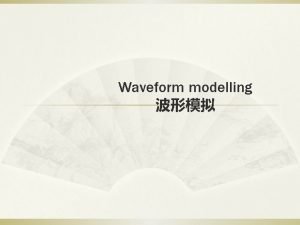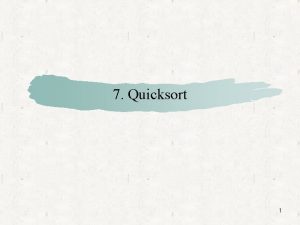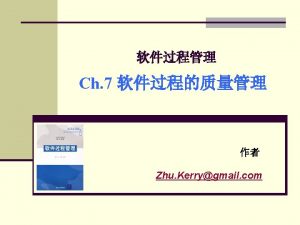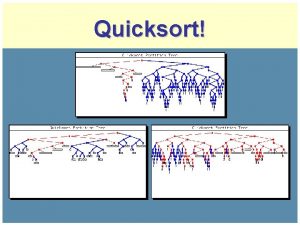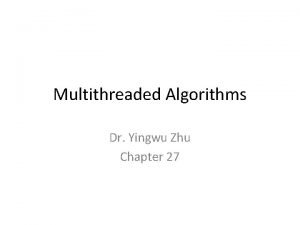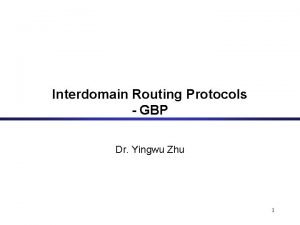Quicksort Dr Yingwu Zhu Quicksort A more efficient










![Recursive Quicksort • void quicksort(int x[], int n) 11 Recursive Quicksort • void quicksort(int x[], int n) 11](https://slidetodoc.com/presentation_image/58c182efd0ad0b5908ffb1636795448a/image-11.jpg)






- Slides: 17

Quicksort Dr. Yingwu Zhu

Quicksort • A more efficient exchange sorting scheme than bubble sort – A typical exchange involves elements that are far apart – Fewer interchanges are required to correctly position an element. • Quicksort uses a divide-and-conquer strategy – A recursive approach – The original problem partitioned into simpler sub-problems, – Each sub problem considered (conquered) independently. • Subdivision continues until sub problems obtained are simple enough to be solved directly simple enough – How simple? 2

Quicksort: Divide/Split • Choose some element called a pivot • Perform a sequence of exchanges so that – All elements that are less than this pivot are to its left. – All elements that are greater than the pivot are to its right. • Divides the (sub)list into two smaller sub lists, • Each of which may then be sorted independently in the same way. 3

Quicksort If the list has 0 or 1 elements, return. // the list is sorted, simple enough! Else do: Pick an element in the list to use as the pivot. Split the remaining elements into two disjoint groups: Split Smaller. Than. Pivot = {all elements <= pivot} Larger. Than. Pivot = {all elements > pivot} Return the list rearranged as: Quicksort(Smaller. Than. Pivot), pivot, Quicksort(Larger. Than. Pivot). 4

Quicksort Example • Given to sort: 68 75, 70, 65, , 98, 78, 100, 93, 55, 61, 81, 84 • Select, arbitrarily, the first element, 75, as pivot. • Search from right for elements <= 75, stop at first element <=75 • Search from left for elements > 75, stop at first element >75 • Swap these two elements, and then repeat this process 5

Quicksort Example 75, 70, 65, 68, 61, 55, 100, 93, 78, 98, 81, 84 • When done, swap with pivot • This SPLIT operation placed pivot 75 so that all elements to the left were <= 75 and all elements to the right were > 75. • 75 is now placed appropriately • Need to sort sublists on either side of 75 6

Quicksort Example • Need to sort (independently): 55, 70, 65, 68, 61 and 100, 93, 78, 98, 81, 84 • Let pivot be 55, look from each end for values larger/smaller than 55, swap • Same for 2 nd list, pivot is 100 • Sort the resulting sublists in the same manner until sublist is trivial (size 0 or 1) 7

Quicksort • Note visual example of a quicksort on an array etc. … 8

Reflection of Quicksort • Perform spilt() operation on a (sub)list, such that: left-sublist, pivot, right-sublist • Recursively and independently perform split() on leftsublist and right-sublist, until their sizes become 0 or 1 (simple enought). • So, the basic operation is split! – int split(int x[], int low, int high) – [low, high] specifies the sublist. – Returns the final position of the pivot 9

Implementing Quicksort • Basic operation: split – Choose the pivot (e. g. , the first element) – Scan the (sub)list from both ends, swap elements such that the resulting left sublist < pivot and right sublist >= pivot – int split (int x[], int first, int last)
![Recursive Quicksort void quicksortint x int n 11 Recursive Quicksort • void quicksort(int x[], int n) 11](https://slidetodoc.com/presentation_image/58c182efd0ad0b5908ffb1636795448a/image-11.jpg)
Recursive Quicksort • void quicksort(int x[], int n) 11

Quicksort: T(n) • Best-case ? • Worst-case ? 12

Quicksort Performance • O(nlog 2 n) is the best case computing time – If the pivot results in sublists of approximately the same size. • O(n 2) worst-case – List already ordered, elements in reverse – When Split() repetitively results, for example, in one empty sublist 13

Improvements to Quicksort • An arbitrary pivot gives a poor partition for nearly sorted lists (or lists in reverse) • Virtually all the elements go into either Smaller. Than. Pivot or Larger. Than. Pivot – all through the recursive calls. • Quicksort takes quadratic time to do essentially nothing at all. 14

Improvements to Quicksort • Better method for selecting the pivot is the medianof-three rule, – Select the median of the first, middle, and last elements in each sublist as the pivot. • Often the list to be sorted is already partially ordered • Median-of-three rule will select a pivot closer to the middle of the sublist than will the “first-element” rule. 15

Improvements to Quicksort • For small files (n <= 20), quicksort is worse than insertion sort; – small files occur often because of recursion. • Use an efficient sort (e. g. , insertion sort) for small files. • Better yet, use Quicksort() until sublists are of a small size and then apply an efficient sort like insertion sort. 16

Non-recursive Quicksort • Think about non-recursive alg. ? 17
 Lirik lagu more more more we praise you
Lirik lagu more more more we praise you More more more i want more more more more we praise you
More more more i want more more more more we praise you Lean office definition
Lean office definition Productively efficient vs allocatively efficient
Productively efficient vs allocatively efficient Allocative efficiency vs productive efficiency
Allocative efficiency vs productive efficiency Productively efficient vs allocatively efficient
Productively efficient vs allocatively efficient Productively efficient vs allocatively efficient
Productively efficient vs allocatively efficient Allocative efficiency
Allocative efficiency Gmail
Gmail Duo chun yu
Duo chun yu Zachary zhu
Zachary zhu Xuding zhu
Xuding zhu Edward zhu
Edward zhu Dou mei zhu
Dou mei zhu Lupei zhu
Lupei zhu Mechanical engineering umbc
Mechanical engineering umbc Zhu shi
Zhu shi Jia zhu de rong yao
Jia zhu de rong yao














